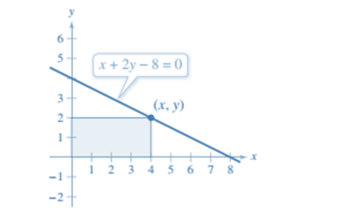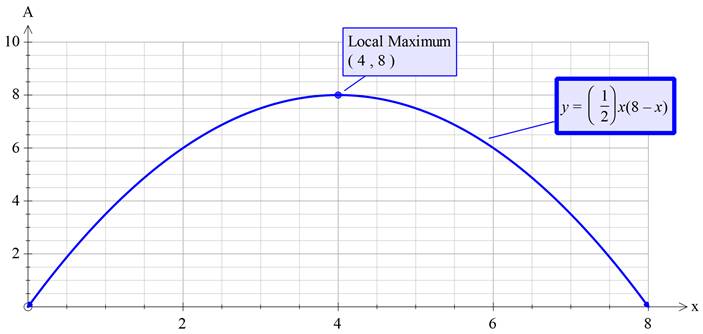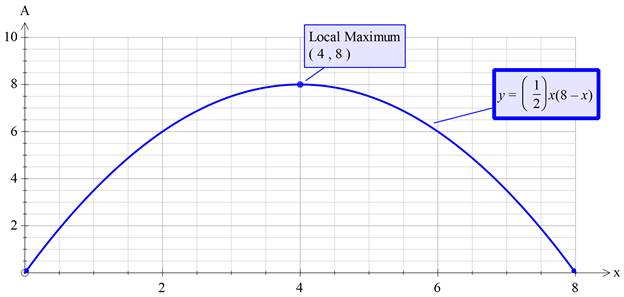
a
To write the area as a function of x and the domain of the respective function.
a
Answer to Problem 13RE
Explanation of Solution
Given:
Equation is

Calculation:
The given equation can be alternatively written as :
From above equation, the co-ordinate ( x , y ) can be written as
From the graph, considering the above condition the area of the rectangle can be written as:
Now, the domain of the given function is the values of x for which the area of rectangle is defined.
Here, the area of rectangle is bounded in the region [0, 8].
Conclusion:
Hence, Area in terms of x will be:
b
To graph the function:
b
Answer to Problem 13RE
At x = 4 and y = 2 the area of the rectangle will be maximum.
Explanation of Solution
Given:
Graph:
By using graphing utility, the graph of area function is,

Interpretation:
From the above graph, it is clear that the maximum area will be 8 at x = 4.
Now, at x = 4,
Conclusion:
Hence, the required dimensions are
c
To solve the function algebraically and verify the answer with the graphical results.
c
Explanation of Solution
Given:
Calculation:
Now, in order to maximize the area
Hence, At x = 4, the area of the rectangle is maximum,
Verification with graph:

Interpretation:
The graph clearly states that at x = 4 the area of the rectangle will be maximum and it is equal to 8 sq. units.
Chapter 2 Solutions
Precalculus with Limits: A Graphing Approach
- I) For what value(s) of x does g(x) = -4? Separate multiple answers with commas as needed. J) Give the interval(s) of such that g(x) > 0. Use the union symbol between multiple intervals. K) Give the interval(s) of such that g(x) <0. Use the union symbol between multiple intervals.arrow_forwardneed help on Barrow_forward4. Use the properties of limits to help decide whether each limit exists. If a limit exists, fi lim (2x²-4x+5) a) x-4 b) lim 2 x²-16 x-4x+2x-8arrow_forward
- 7. The concentration of a drug in a patient's bloodstream h hours after it was injected is given by 0.17 h Ah= h²+2' Find and interpret lim A(h). Remember, the answers to word problems should always be given in a complete h→00 sentence, with proper units, in the context of the problem.arrow_forward#2arrow_forward2. We want to find the inverse of f(x) = (x+3)² a. On the graph at right, sketch f(x). (Hint: use what you know about transformations!) (2 points) b. What domain should we choose to get only the part of f (x) that is one- to-one and non-decreasing? Give your answer in inequality notation. (2 points) - c. Now use algebra to find f¯¹ (x). (2 points) -4- 3- 2 1 -4 -3 -2 -1 0 1 -1- -2- --3- -4 -N- 2 3 4arrow_forward
- 1. Suppose f(x) = 2 4 == x+3 and g(x) = ½-½. Find and fully simplify ƒ(g(x)). Be sure to show all x your work, write neatly so your work is easy to follow, and connect your expressions with equals signs. (4 points)arrow_forwardFind the ane sided limit lim 2 x+1-3x-3arrow_forward4 44 3+ 2+ -4-3 -2 -1 2 3 4 -2 -3. Find the values at X which the graph is discontinuous and categorize them.arrow_forward
 Calculus: Early TranscendentalsCalculusISBN:9781285741550Author:James StewartPublisher:Cengage Learning
Calculus: Early TranscendentalsCalculusISBN:9781285741550Author:James StewartPublisher:Cengage Learning Thomas' Calculus (14th Edition)CalculusISBN:9780134438986Author:Joel R. Hass, Christopher E. Heil, Maurice D. WeirPublisher:PEARSON
Thomas' Calculus (14th Edition)CalculusISBN:9780134438986Author:Joel R. Hass, Christopher E. Heil, Maurice D. WeirPublisher:PEARSON Calculus: Early Transcendentals (3rd Edition)CalculusISBN:9780134763644Author:William L. Briggs, Lyle Cochran, Bernard Gillett, Eric SchulzPublisher:PEARSON
Calculus: Early Transcendentals (3rd Edition)CalculusISBN:9780134763644Author:William L. Briggs, Lyle Cochran, Bernard Gillett, Eric SchulzPublisher:PEARSON Calculus: Early TranscendentalsCalculusISBN:9781319050740Author:Jon Rogawski, Colin Adams, Robert FranzosaPublisher:W. H. Freeman
Calculus: Early TranscendentalsCalculusISBN:9781319050740Author:Jon Rogawski, Colin Adams, Robert FranzosaPublisher:W. H. Freeman
 Calculus: Early Transcendental FunctionsCalculusISBN:9781337552516Author:Ron Larson, Bruce H. EdwardsPublisher:Cengage Learning
Calculus: Early Transcendental FunctionsCalculusISBN:9781337552516Author:Ron Larson, Bruce H. EdwardsPublisher:Cengage Learning





